Abstract
Acute ankle sprain is the most common injury in the lower extremities, and approximately 10% to 40% of acute lateral ankle ligament injury causes chronic pain or instability. For chronic symptoms lasting after an acute sprain, the possibility of joint damage, such as bony structures, ligaments, cartilage, and nerves around the ankle joint, should be considered. Patients with chronic lateral ankle instability usually complain of repeated sprains or giving way sensations. There has been steady progress in the treatment options until recently, however new treatments are still being attempted. This paper describes the causes, diagnosis, and recent trends in the conservative and operative treatment of chronic lateral ankle instability.
Go to : 
References
1. Karlsson J, Lansinger O. Lateral instability of the ankle joint. Clin Orthop Relat Res. 1992; 276:253–61.

2. Peters JW, Trevino SG, Renstrom PA. Chronic lateral ankle instability. Foot Ankle. 1991; 12:182–91. doi:. DOI: 10.1177/107110079101200310.

3. van Rijn RM, van Os AG, Bernsen RM, Luijsterburg PA, Koes BW, Bier-ma-Zeinstra SM. What is the clinical course of acute ankle sprains? A systematic literature review. Am J Med. 2008; 121:324–31.e6. doi:. DOI: 10.1016/j.amjmed.2007.11.018.

4. Milner CE, Soames RW. Anatomical variations of the anterior talofibular ligament of the human ankle joint. J Anat. 1997; 191(Pt 3):): 457-8.doi:. DOI: 10.1046/j.1469-7580.1997.19130457.x.

5. Dalmau-Pastor M, Malagelada F, Calder J, Manzanares MC, Vega J. The lateral ankle ligaments are interconnected: the medial connecting fibres between the anterior talofibular, calcaneofibular and posterior talofibular ligaments. Knee Surg Sports Traumatol Arthrosc. 2020; 28:34–9. doi:. DOI: 10.1007/s00167-019-05794-8.

6. Golanó P, Vega J, de Leeuw PA, Malagelada F, Manzanares MC, Götzens V, et al. Anatomy of the ankle ligaments: a pictorial essay. Knee Surg Sports Traumatol Arthrosc. 2016; 24:94456. doi:. DOI: 10.1007/s00167-016-4059-4.

7. Tropp H, Odenrick P, Gillquist J. Stabilometry recordings in functional and mechanical instability of the ankle joint. Int J Sports Med. 1985; 6:180–2. doi:. DOI: 10.1055/s-2008-1025836.

8. Freeman MA. Instability of the foot after injuries to the lateral ligament of the ankle. J Bone Joint Surg Br. 1965; 47:669–77.
9. Hertel J. Functional anatomy, pathomechanics, and pathophysiology of lateral ankle instability. J Athl Train. 2002; 37:364–75.
10. DiGiovanni CW, Brodsky A. Current concepts: lateral ankle instability. Foot Ankle Int. 2006; 27:854–66. doi:. DOI: 10.1177/107110070602701019.

11. Komenda GA, Ferkel RD. Arthroscopic findings associated with the unstable ankle. Foot Ankle Int. 1999; 20:708–13. doi:. DOI: 10.1177/107110079902001106.

12. Renstrom PA. Persistently painful sprained ankle. J Am Acad Orthop Surg. 1994; 2:270–80.
13. Park HJ, Cha SD, Kim HS, Chung ST, Park NH, Yoo JH, et al. Reliability of MRI findings of peroneal tendinopathy in patients with lateral chronic ankle instability. Clin Orthop Surg. 2010; 2:237–43. doi:. DOI: 10.4055/cios.2010.2.4.237.

14. Kobayashi T, Gamada K. Lateral ankle sprain and chronic ankle instability: a critical review. Foot Ankle Spec. 2014; 7:298–326.
15. Webster KA, Gribble PA. Functional rehabilitation interventions for chronic ankle instability: a systematic review. J Sport Rehabil. 2010; 19:98–114. doi:. DOI: 10.1123/jsr.19.1.98.

16. Rodriguez-Merchan EC. Chronic ankle instability: diagnosis and treatment. Arch Orthop Trauma Surg. 2012; 132:211–9. doi:. DOI: 10.1007/s00402-011-1421-3.

17. Coughlin MJ, Saltzman CL, Anderson RB. Mann's surgery of the foot and ankle. 9th ed.Philadelphia: Elsevier;2014.
18. Park YH, Kim HJ. Conservative management and postoperative rehabilitation of chronic lateral ankle instability. J Korean Foot Ankle Soc. 2019; 23:6–11. doi:. DOI: 10.14193/jkfas.2019.23.1.6.

19. Ajis A, Maffulli N. Conservative management of chronic ankle instability. Foot Ankle Clin. 2006; 11:531–7. doi:. DOI: 10.1016/j.fcl.2006.07.004.

20. Maffulli N, Ferran NA. Management of acute and chronic ankle instability. J Am Acad Orthop Surg. 2008; 16:608–15. doi:. DOI: 10.5435/00124635-200810000-00006.

21. McKeon PO, Hertel J. Systematic review of postural control and lateral ankle instability, part II: is balance training clinically effective? J Athl Train. 2008; 43:305–15. doi:. DOI: 10.4085/1062-6050-43.3.305.

22. Noailles T, Lopes R, Padiolleau G, Gouin F, Brilhault J. Nonanatomical or direct anatomical repair of chronic lateral instability of the ankle: a systematic review of the literature after at least 10 years of follow-up. Foot Ankle Surg. 2018; 24:80–5. doi:. DOI: 10.1016/j.fas.2016.10.005.

23. Gould N, Seligson D, Gassman J. Early and late repair of lateral ligament of the ankle. Foot Ankle. 1980; 1:84–9. doi:. DOI: 10.1177/107110078000100206.

24. Snook GA, Chrisman OD, Wilson TC. Long-term results of the Chrisman-Snook operation for reconstruction of the lateral ligaments of the ankle. J Bone Joint Surg Am. 1985; 67:1–7.

25. Kibler WB. Arthroscopic findings in ankle ligament reconstruction.
26. Taga I, Shino K, Inoue M, Nakata K, Maeda A. Articular cartilage lesions in ankles with lateral ligament injury. An arthroscopic study. Am J Sports Med. 1993; 21:120–6. doi:. DOI: 10.1177/036354659302100120.
27. Duquennoy A, Létendard J, Loock P. [Chronic instability of the ankle treated by reefing of the lateral ligament (author's transl)]. Rev Chir Orthop Reparatrice Appar Mot. 1980; 66:311–6. French.
28. Choi HJ, Kim DW, Park JS. Modified Broström procedure using distal fibular periosteal flap augmentation vs anatomic reconstruction using a free tendon allograft in patients who are not candidates for standard repair. Foot Ankle Int. 2017; 38:1207–14. doi:. DOI: 10.1177/1071100717726303.

29. Coetzee JC, Ellington JK, Ronan JA, Stone RM. Functional results of open Broström ankle ligament repair augmented with a suture tape. Foot Ankle Int. 2018; 39:304–10. doi:. DOI: 10.1177/1071100717742363.

30. Giza E, Whitlow SR, Williams BT, Acevedo JI, Mangone PG, Hayt-manek CT, et al. Biomechanical analysis of an arthroscopic Broström ankle ligament repair and a suture anchor-augmented repair. Foot Ankle Int. 2015; 36:836–41. doi:. DOI: 10.1177/1071100715576539.

31. Guelfi M, Zamperetti M, Pantalone A, Usuelli FG, Salini V, Oliva XM. Open and arthroscopic lateral ligament repair for treatment of chronic ankle instability: a systematic review. Foot Ankle Surg. 2018; 24:11–8. doi:. DOI: 10.1016/j.fas.2016.05.315.

32. Rigby RB, Cottom JM. A comparison of the “all-inside” arthroscopic Broström procedure with the traditional open modified Broström-Gould technique: a review of 62 patients. Foot Ankle Surg. 2019; 25:31–6. doi:. DOI: 10.1016/j.fas.2017.07.642.

33. Yoshimura I, Hagio T, Noda M, Kanazawa K, Minokawa S, Yamamoto T. Optimal suture anchor direction in arthroscopic lateral ankle ligament repair. Knee Surg Sports Traumatol Arthrosc. 2018; 26:2110–5. doi:. DOI: 10.1007/s00167-017-4587-6.

34. Tourné Y, Mabit C. Lateral ligament reconstruction procedures for the ankle. Orthop Traumatol Surg Res. 2017; 103(1S):): S171-81.doi:. DOI: 10.1016/j.otsr.2016.06.026.

Go to : 
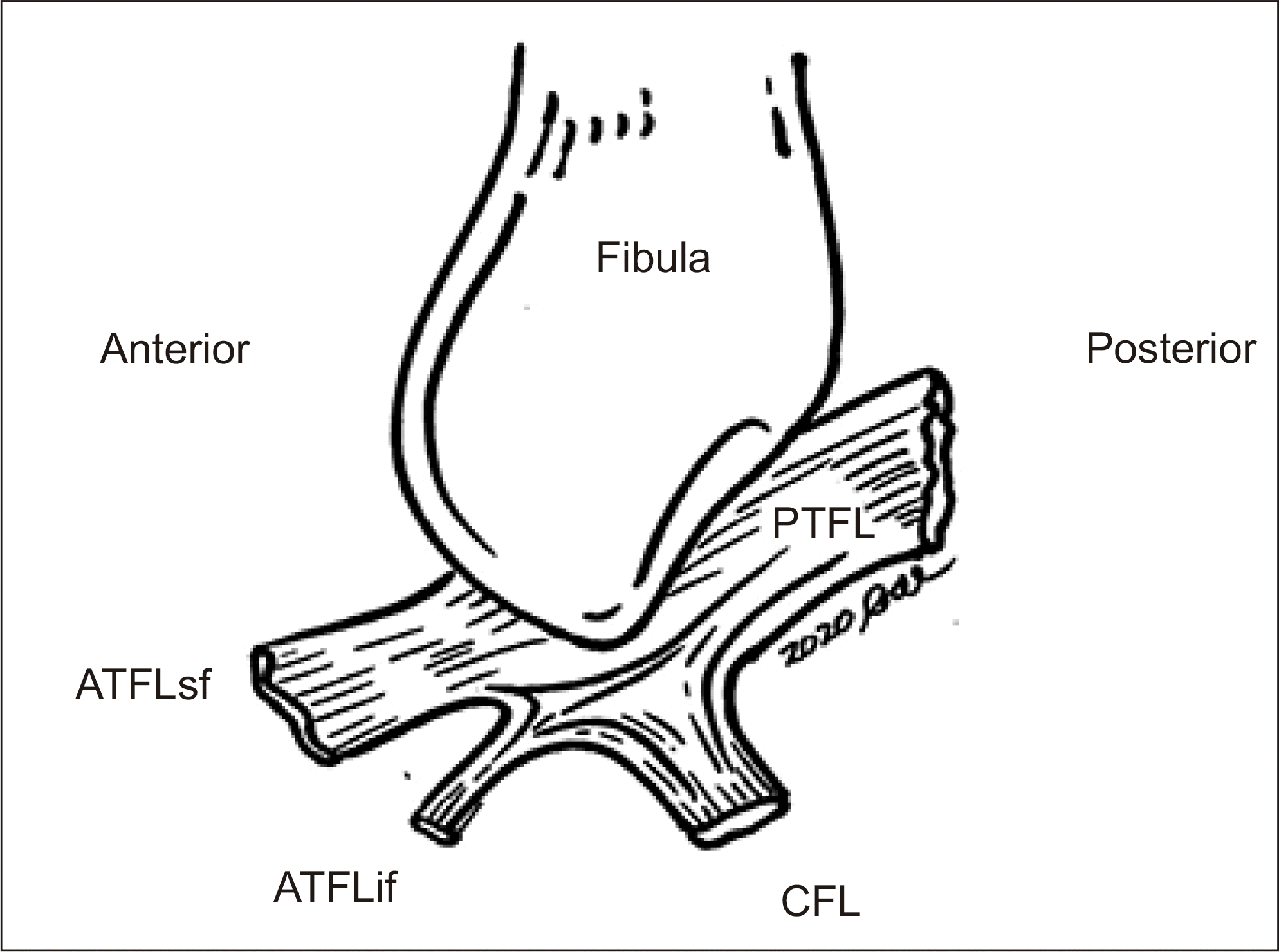 | Figure 1.Lateral fibulotalocalcaneal ligament complex has variable connections between anterior talofibular ligament superior fascicle (ATFLsf), ATFL inferior fascicle (ATFLif), CFL, and PTFL. CFL: calcaneofibular ligament, PTFL: posterior talofibular ligament. |
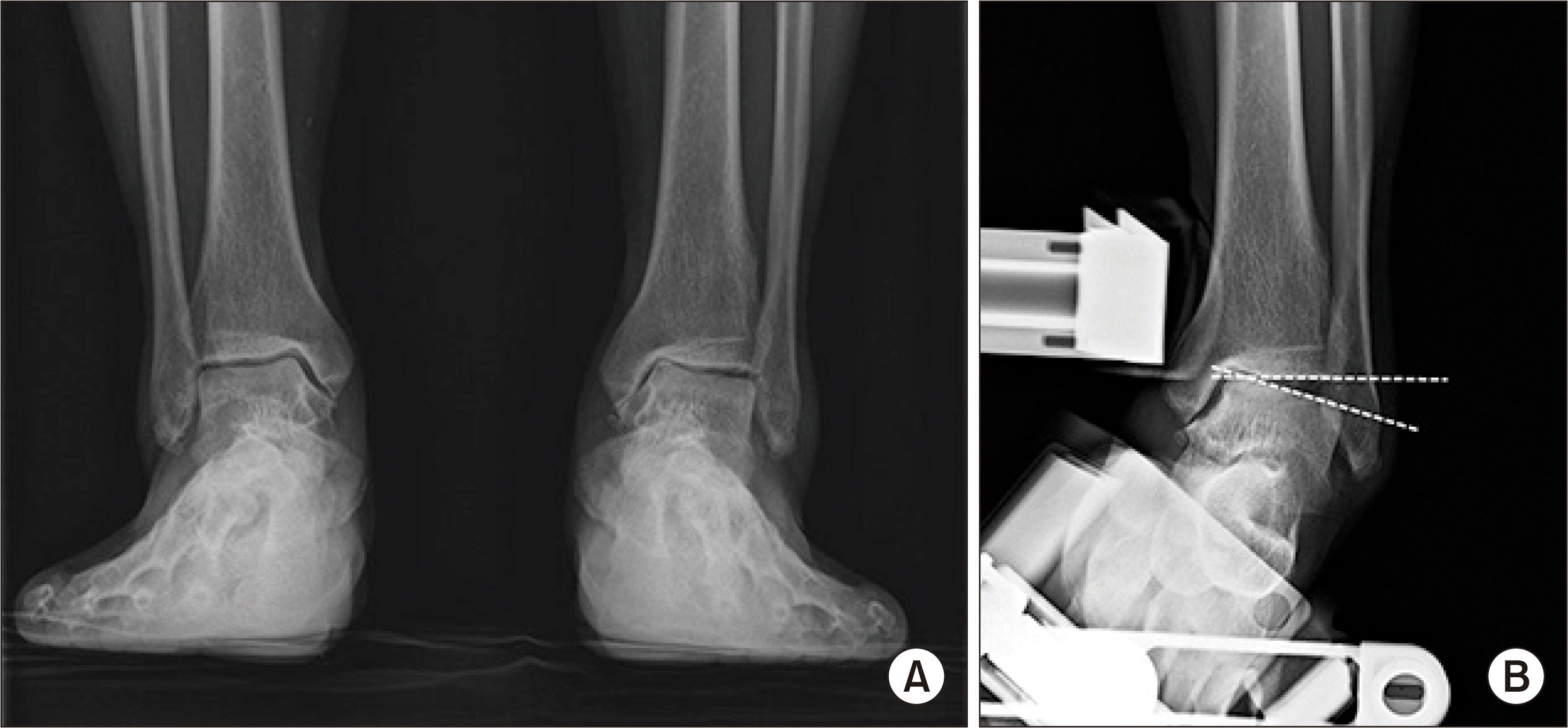 | Figure 2.Standing anteroposterior radiograph of 50-year-old male patient showed varus arthritis of left ankle which might be caused by chronic lateral instability (A). Abnormal talar tilt (14 degrees) was seen on his varus stress radiograph (B). |
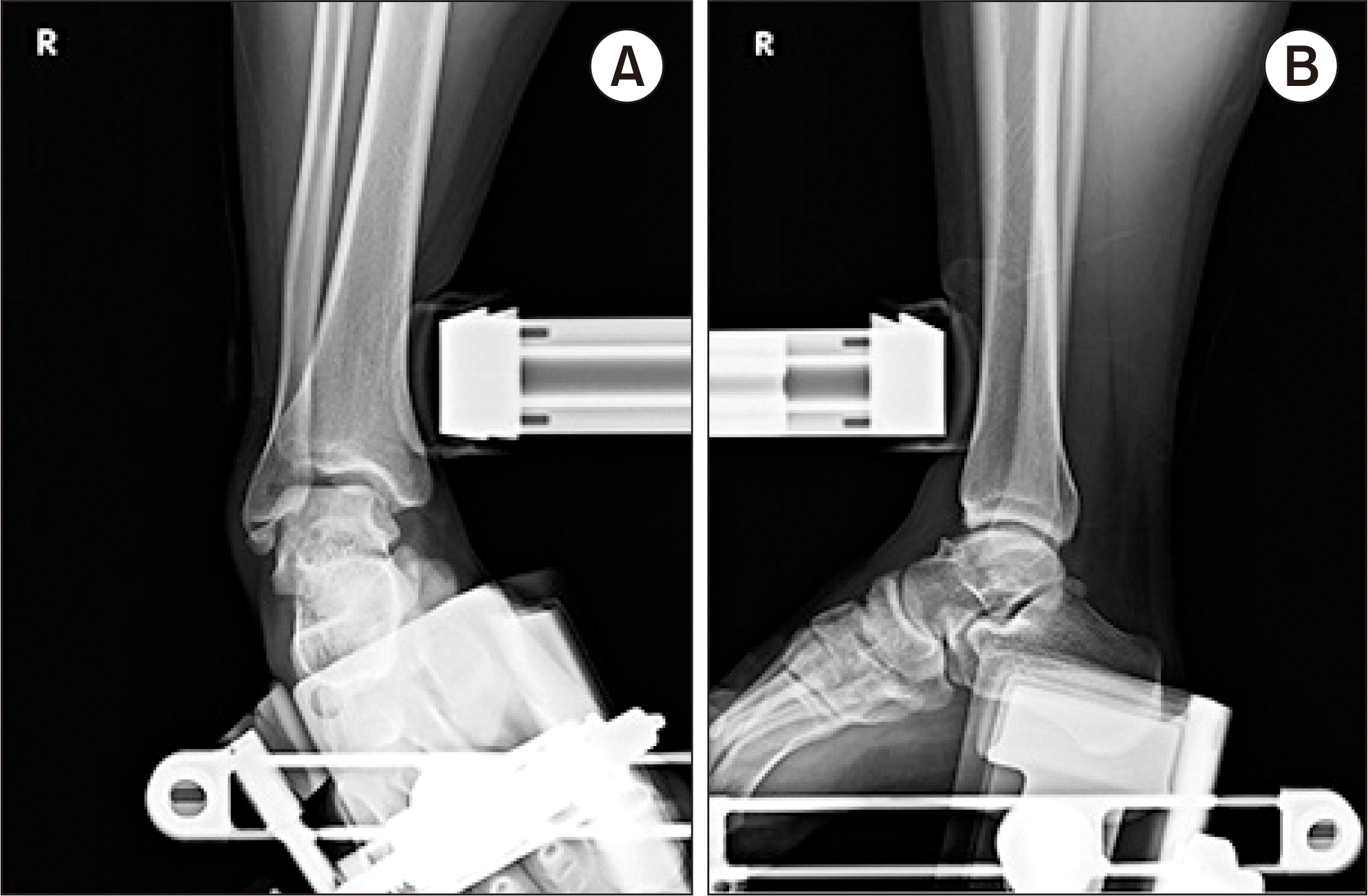 | Figure 3.Anterior bony spur was revieled on radiograph of 18-year-old male who complained of impinging pain and subjective instability. And there was no mechanical instability, neither on varus (A) and anterior draw (B) stress radiograph. |
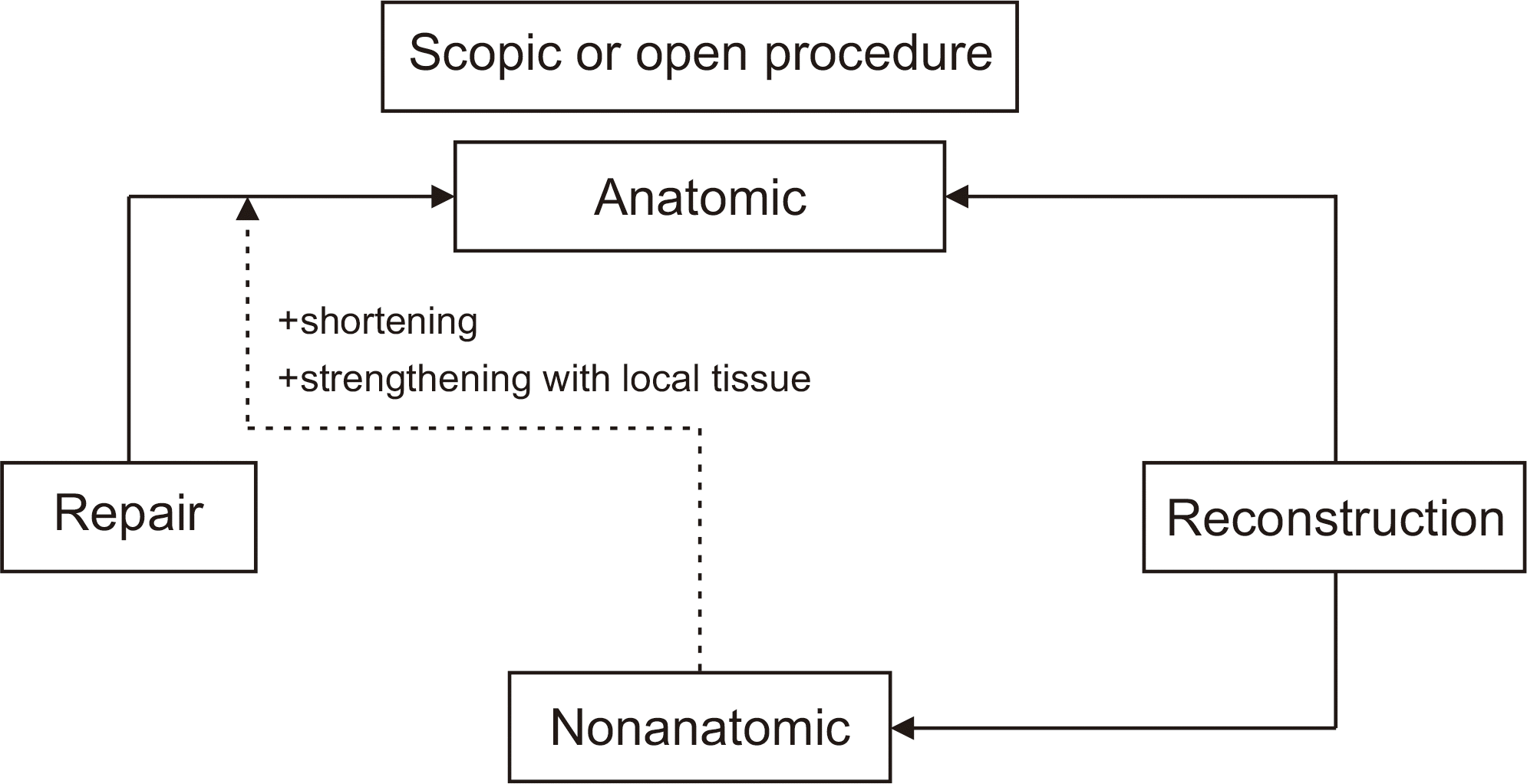 | Figure 4.Classification of operative methods for chronic mechanical instability of the ankle joint. |




 PDF
PDF ePub
ePub Citation
Citation Print
Print


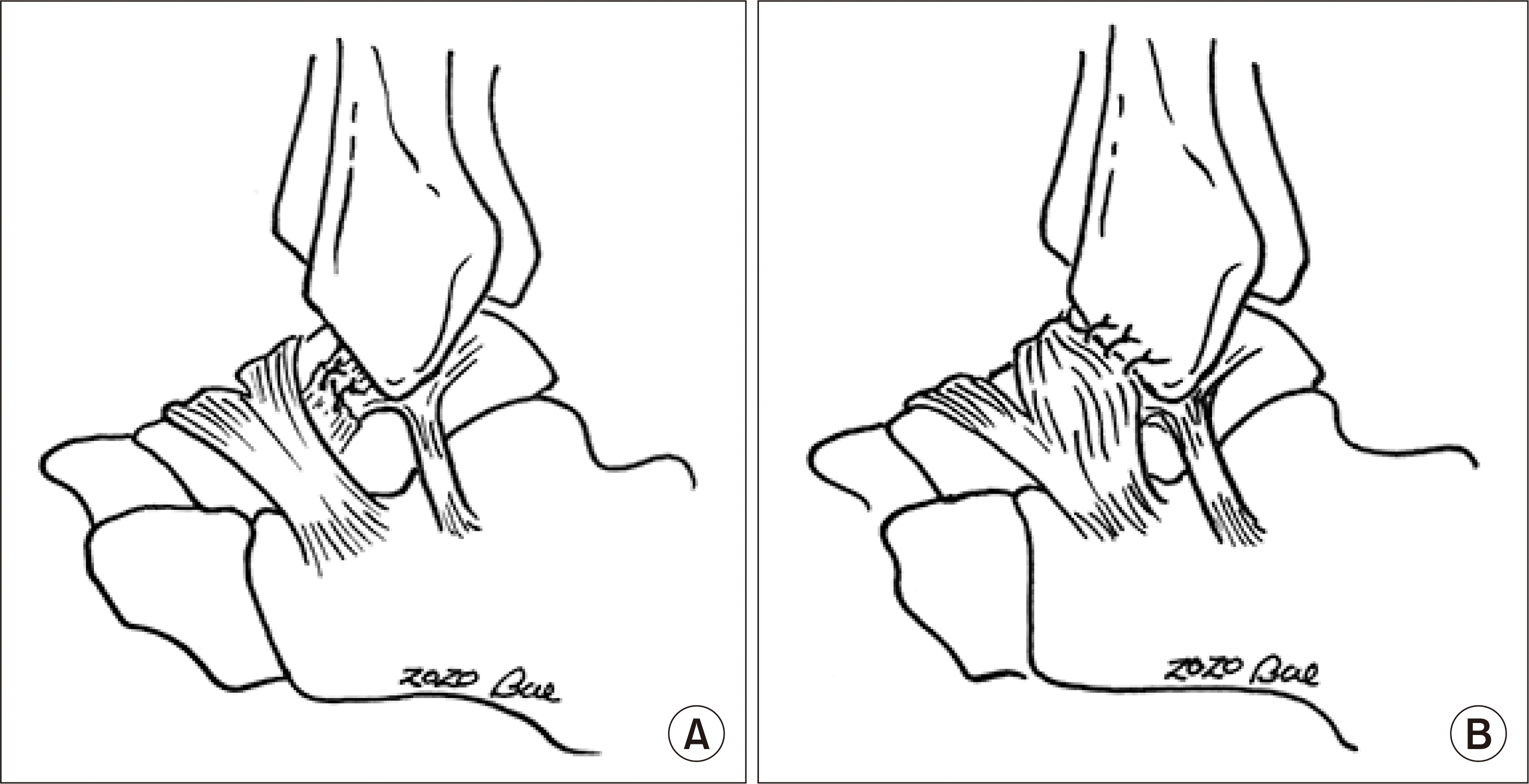
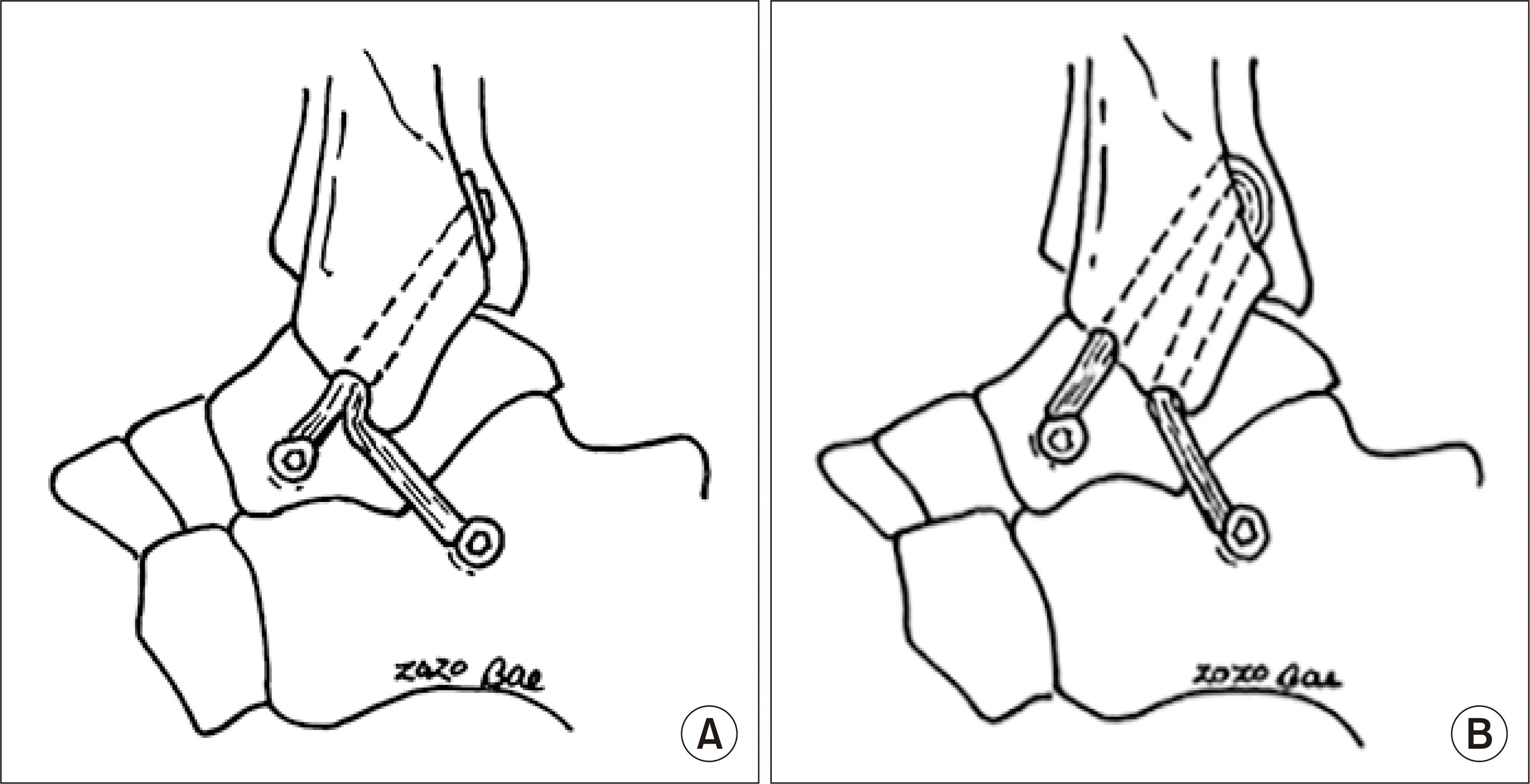
 XML Download
XML Download